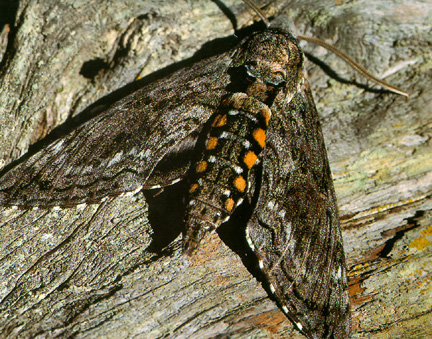Manduca blackburni
Manduca blackburni
Blackburn's Sphinx Moth
(Butler, 1880)

Manduca blackburni courtesy of W. P. Mull.
This site has been created by
Bill Oehlke at oehlkew@islandtelecom.com
Comments, suggestions and/or additional information are welcomed by Bill.
TAXONOMY:
Family: Sphingidae, Latreille, 1802
Subfamily: Sphinginae, Latreille, [1802]
Tribe: Sphingini, Latreille, 1802
Genus: Manduca Hubner, [1807] ...........
Species: blackburni (Butler, 1880)
|
MIDI MUSIC
.....It's a Wonderful World.....
copyright C. Odenkirk
ON.OFF
<bgsound src="world.mid" LOOP=FOREVER>
|
DISTRIBUTION:
Blackburn's Sphinx Moth, Manduca blackburni,
flies in Hawaii.
Previously known from all the main islands, this rare endemic Hawaiian sphinx moth is now known only from Maui.
It is normally found in coastal and dry forests. It is a close relative of the tomato horn worm of North America. It is the
first Hawaiian insect to be proposed as endangered.
FLIGHT TIMES:
Manduca blackburni adults fly
ECLOSION:
Pupae probably wiggle to surface from subterranean chambers just prior to eclosion.
SCENTING AND MATING:
Females call in the males with a pheromone released from a gland at the tip of the
abdomen. Adults take nectar from flowers.
EGGS, LARVAE, PUPAE:
Larvae have been reported on
Lycopersicon, Nicotiana, Nicotiana glauca, Nothocestrum latifolium
and Solanum melongena.

Manduca blackburni green form, Puu o Kali, Maui, Hawaii,
November 23, 2002, courtesy of Forest & Kim Starr.

Manduca blackburni brown form, Kanaha Beach, Maui, Hawaii,
December 14, 2006, courtesy of Forest & Kim Starr.
Return to Sphingidae Index
Return to Sphingini Tribe
September til January
Previously known from all the main islands, this rare endemic Hawaiian sphinx moth is now known only from Maui. It is normally found in coastal and dry forests.
It is a close relative of the tomato horn worm of North America. It is the first
Hawaiian insect to be proposed as endangered.
Here you see the large caterpillar of the sphinx moth
(Manduca blackburni) which may occur in either gray or green color
forms with white ‘racing stripe’ designs. Previously believed
extinct, this large moth had not been seen for many years.
(Photos: Betsy Gagne) green and dark forms
Development from egg to adult can take as little as 56 days, but pupae may aestivate (dormancy during a period when conditions are hot and dry) in the soil for
as long as a year. Adult moths can be found year round but seem to be most active during two periods, January to April and September to November. Adult moths are
strong fliers.
Once found on six Hawaiian islands, the moth now exists only on Maui,
Kaho`olawe, and the island of Hawai`i. They were believed extinct
until 1984 when a small population was rediscovered in a lowland dry
forest on the south coast of East Maui (Kanaio area). Additional
small isolated populations are now known from other parts of Maui.
Populations were recently discovered on Kaho`olawe (the first record
of this species on this island) in 1997 and in 1998 in North Kona on
the island of Hawaii.
Threats to Blackburn’s Sphinx Moth include introduced ants and
parasitic wasps that prey on the eggs and caterpillars, and the loss
of its native host plant, `aiea, which is a dryland forest tree.
Eric Hossler writes, December 2011: Manduca blackburni - fully mature larvae very commonly observed on Nicotiana glauca, on Maui,
along Mokulele highway, March 2011. Damage to the plant was pretty easily spotted, and larvae were right on the tips of the branches. I also saw one ova in
October 2010, and leaf damage, but both of these could have been old.


